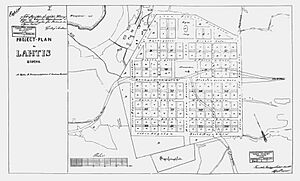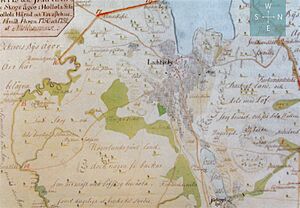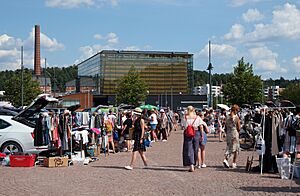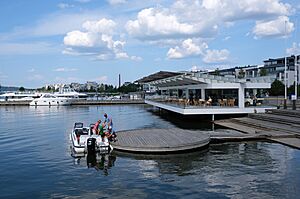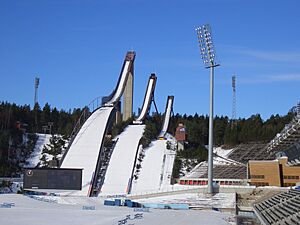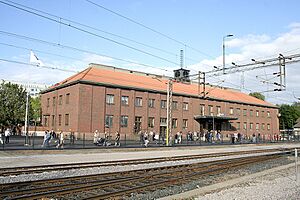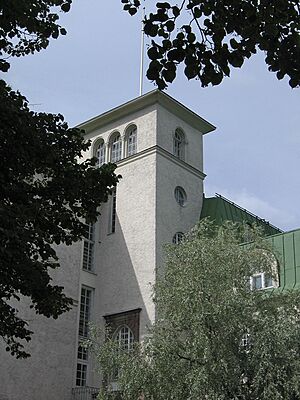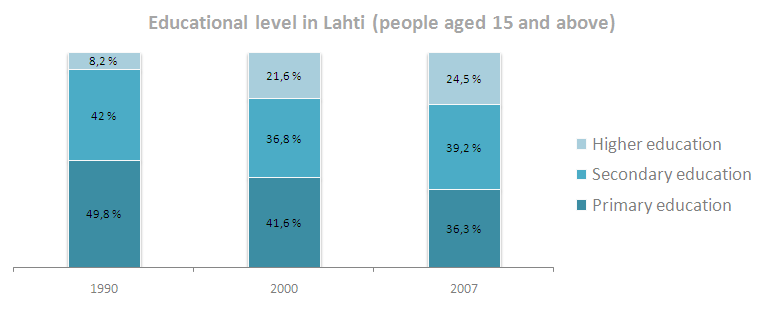Lahti facts for kids
Quick facts for kids
Lahti
Lahtis
|
||
|---|---|---|
|
City
|
||
| Lahden kaupunki Lahtis stad City of Lahti |
||

Centre of the city
|
||
|
||
| Nickname(s):
Chicago of Finland, Business City
|
||
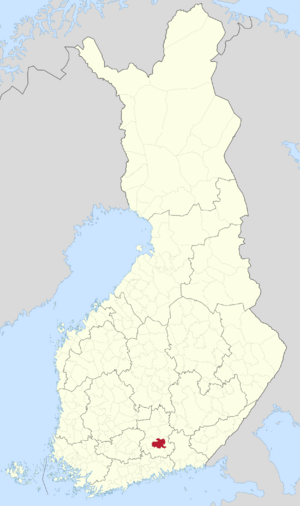
Location of Lahti in Finland
|
||
| Country | ||
| Region | ||
| Sub-region | Lahti sub-region | |
| Charter | June 5, 1878 | |
| City | November 1, 1905 | |
| Area
(2018-01-01)
|
||
| • Total | 517.63 km2 (199.86 sq mi) | |
| • Land | 459.5 km2 (177.4 sq mi) | |
| • Water | 19.53 km2 (7.54 sq mi) | |
| Area rank | 191st largest in Finland | |
| Population
(2023-12-31)
|
||
| • Total | 120,693 | |
| • Rank | 9th largest in Finland | |
| • Density | 262.66/km2 (680.3/sq mi) | |
| Population by native language | ||
| • Finnish | 90.2% (official) | |
| • Swedish | 0.4% | |
| • Others | 9.3% | |
| Population by age | ||
| • 0 to 14 | 14.3% | |
| • 15 to 64 | 60.8% | |
| • 65 or older | 24.9% | |
| Time zone | UTC+02:00 (EET) | |
| • Summer (DST) | UTC+03:00 (EEST) | |
Lahti is a city in Finland. It is the main city of the Päijät-Häme region. Lahti is located in the Finnish Lakeland, a beautiful area with many lakes. About 121,000 people live in Lahti. It is one of the biggest cities in Finland.
The city sits on a bay at the southern end of Vesijärvi lake. It is about 100 kilometres (60 mi) northeast of Helsinki, the capital of Finland. Lahti is an important meeting point for two major highways. These roads connect it to other big cities like Jyväskylä, Tampere, and Kouvola.
The Finnish word "Lahti" means bay. The city is sometimes called the "Chicago of Finland." This is because both cities grew with industries like meatpacking. Also, both cities had some tough times with crime in their early days.
Lahti is a leader in protecting the environment. It has been working on sustainability since the 1990s. The European Commission even named Lahti the European Green Capital for 2021.
Lahti is also home to the Salpausselkä UNESCO Global Geopark. This is one of four UNESCO Geoparks in Finland. It was added to the list in 2022.
The city's coat of arms shows a train wheel with flames. This design represents the Riihimäki–Saint Petersburg railway. This railway was very important for Lahti becoming a city.
Contents
History of Lahti
Lahti was first mentioned in old papers in 1445. It was a small village that belonged to the parish of Hollola. The village was on an old trade route that connected Hämeenlinna and Viipuri.
In 1870, the Riihimäki – St. Petersburg railway line was finished. A year later, the Vesijärvi canal was also completed. These new transport links made Lahti a busy place. Factories and industries started to appear around the railway station. For a long time, the station at Vesijärvi Harbour was the second busiest in Finland. Many workers, craftsmen, and merchants moved to the area.
On June 19, 1877, a big fire burned almost the entire village. But this accident actually helped Lahti grow. It made the authorities decide to officially make Lahti a town. In 1878, Emperor Alexander II of Russia gave Lahti the right to hold a market. A new town plan was approved. It had a large market square and wide streets. This plan is still the basis of the city center today. Most early buildings were small wooden houses.
Lahti became a city during a difficult economic time. The Russian Empire was fighting a war, which affected Finland's economy. This slowed down building in Lahti. Land was hard to sell, and many plots stayed empty. In its early years, the town had only about 200 people. It was too small for much trade.
By the late 1890s, Lahti's leaders worked hard to make it a city. In 1904, their efforts paid off. The Senate approved the idea. Then, Tsar Nicholas II finally gave his approval. Lahti officially became a city on November 1, 1905.
By the end of 1905, about 8,200 people lived in the Lahti area. Nearly 3,000 of them lived in the new city. Essential public buildings like a hospital and city hall were built quickly. More brick houses started to appear in the city center. In 1918, the Battle of Lahti took place during the Finnish Civil War. German troops took the city from the Red Guards.
In the early 1920s, the city gained control of the Lahti Manor land. This land was important because it connected the city to the lake. Industries grew fast in the 1930s, and the population increased. Lahti was one of Finland's fastest-growing cities. Before World War II, nearly 30,000 people lived there.
Lahti continued to grow by adding new areas in 1924, 1933, and 1956. The population grew a lot after WWII. About 10,000 people who had to leave their homes were settled in Lahti. More people moved to the city in the 1960s and 1970s. This fast growth slowed down in 1975. However, Lahti grew again in 2016 when the nearby area of Nastola became part of the city.
In December 2018, Lahti became Finland's newest university city. This happened when the Parliament changed the university law. Now, LUT University has two campuses: one in Lappeenranta and one in Lahti.
Geography and Climate

Lahti's landscape is shaped by the Salpausselkä ridge. This long hill runs through the city from west to east. North of the ridge, you'll find rocky hills and many small lakes. South of it, there are more forests and small rivers. The soil also changes: it's mostly rocky in the north and clay in the south.
The largest lake is Vesijärvi. It's a gateway to Central Finland through Lake Päijänne. There's also a smaller pond called Pikku-Vesijärvi ("Little Vesijärvi") near the Lanu-puisto park.
City Areas
The city of Lahti is divided into 40 numbered districts. It also has 9 larger areas. These larger areas are split into 41 statistical districts and 169 smaller statistical areas. Here are some of the districts:
- Keski-Lahti
- Kartano
- Paavola
- Niemi
- Kiveriö
- Kivimaa
- Mukkula
- Kilpiäinen
- Pesäkallio
- Kytölä
- Viuha
- Kunnas
- Ahtiala
- Koiskala
- Myllypohja
- Möysä
- Järvenpää
- Kolava
- Kujala
- Kerinkallio
- Ämmälä
- Renkomäki
- Nikkilä
- Laune
- Asemantausta
- Sopenkorpi
- Hennala
- Jokimaa
- Okeroinen
- Kärpänen
- Pirttiharju
- Salpausselkä
- Jalkaranta
- Villähde
- Nastola
- Uusikylä
- Seesta
- Ruuhijärvi
- Immilä
- Pyhäntaka
Lahti's Climate
Lahti has a humid continental climate. This means it has warm summers and cold, long winters. In July, the average daily temperature is usually over 23 °C (73.6 °F). Lahti has had many hot days over 25 °C (77 °F) in recent years. Winters are getting milder because of climate change.
The highest temperature ever recorded in Lahti was 35.0 °C (95 °F) during a heatwave in 2010. Rain and snow are spread fairly evenly throughout the year. Spring is usually the driest season. The second half of the year gets the most precipitation.
| Climate data for Lahti Laune (1991–2020 normals, extremes 1938–05/2019 from Laune, 05/2019 -present from Sopenkorpi) | |||||||||||||
|---|---|---|---|---|---|---|---|---|---|---|---|---|---|
| Month | Jan | Feb | Mar | Apr | May | Jun | Jul | Aug | Sep | Oct | Nov | Dec | Year |
| Record high °C (°F) | 7.9 (46.2) |
9.6 (49.3) |
16.6 (61.9) |
24.5 (76.1) |
30.1 (86.2) |
32.5 (90.5) |
35.0 (95.0) |
33.8 (92.8) |
27.6 (81.7) |
18.8 (65.8) |
13.2 (55.8) |
10.4 (50.7) |
35.0 (95.0) |
| Mean daily maximum °C (°F) | −3.0 (26.6) |
−2.9 (26.8) |
2.1 (35.8) |
9.1 (48.4) |
16.3 (61.3) |
20.1 (68.2) |
23.1 (73.6) |
21.1 (70.0) |
15.2 (59.4) |
7.9 (46.2) |
2.4 (36.3) |
−0.9 (30.4) |
9.2 (48.6) |
| Daily mean °C (°F) | −5.9 (21.4) |
−6.3 (20.7) |
−2.5 (27.5) |
3.6 (38.5) |
10.1 (50.2) |
14.3 (57.7) |
17.2 (63.0) |
15.2 (59.4) |
10.0 (50.0) |
4.3 (39.7) |
0.1 (32.2) |
−3.4 (25.9) |
4.7 (40.5) |
| Mean daily minimum °C (°F) | −9.1 (15.6) |
−9.8 (14.4) |
−6.8 (19.8) |
−1.4 (29.5) |
3.7 (38.7) |
8.5 (47.3) |
11.7 (53.1) |
10.1 (50.2) |
5.7 (42.3) |
1.1 (34.0) |
−2.3 (27.9) |
−6.1 (21.0) |
0.4 (32.8) |
| Record low °C (°F) | −40.6 (−41.1) |
−35.6 (−32.1) |
−31.4 (−24.5) |
−19.3 (−2.7) |
−7.0 (19.4) |
−2.6 (27.3) |
1.5 (34.7) |
−2.0 (28.4) |
−8.4 (16.9) |
−16.5 (2.3) |
−23.8 (−10.8) |
−33.1 (−27.6) |
−40.6 (−41.1) |
| Average precipitation mm (inches) | 48.2 (1.90) |
34.3 (1.35) |
35.1 (1.38) |
28.1 (1.11) |
42.6 (1.68) |
64.5 (2.54) |
77.2 (3.04) |
75.3 (2.96) |
58.4 (2.30) |
65.5 (2.58) |
58.4 (2.30) |
50.1 (1.97) |
637.7 (25.11) |
| Average precipitation days | 12.0 | 8.8 | 8.6 | 6.6 | 7.8 | 9.4 | 10.1 | 10.4 | 9.8 | 11.2 | 11.4 | 11.7 | 117.8 |
| Source 1: FMI climatological normals for Finland 1981–2010 | |||||||||||||
| Source 2: record highs and lows 1961– present
FMI(record highs and lows 1938–1961) |
|||||||||||||
People and Languages
Lahti's Population
| Historical population | ||
|---|---|---|
| Year | Pop. | ±% |
| 1878 | 200 | — |
| 1910 | 5,081 | +2440.5% |
| 1920 | 7,200 | +41.7% |
| 1930 | 10,868 | +50.9% |
| 1940 | 27,878 | +156.5% |
| 1950 | 44,759 | +60.6% |
| 1960 | 66,802 | +49.2% |
| 1970 | 88,393 | +32.3% |
Lahti has about 120,693 residents. This makes it the 9th most populated city in Finland. The wider Lahti region has about 204,479 people. This is the fifth largest region in Finland.
About 9.6% of Lahti's population has a foreign background. This is close to the national average for Finland. However, it is lower than in bigger cities like Helsinki or Tampere.
| Year | Population |
|---|---|
| 1980 |
108,631
|
| 1985 |
108,919
|
| 1990 |
108,272
|
| 1995 |
110,038
|
| 2000 |
111,656
|
| 2005 |
113,582
|
| 2010 |
116,582
|
| 2015 |
118,743
|
| 2020 |
119,917
|
Languages Spoken
Population by mother tongue (2023) Finnish (90.2%) Russian (2.8%) Arabic (1.1%) Estonian (0.7%) Kurdish (0.6%) Swedish (0.4%) Ukrainian (0.4%) Other (3.7%)
Most people in Lahti speak Finnish. About 0.4% of the population speaks Swedish. Since English and Swedish are taught in schools, many people can speak more than one language.
Over 100 different languages are spoken in Lahti. The most common foreign languages are Russian, Arabic, Estonian, and Kurdish.
Immigration in Lahti
| Population by country of birth (2022) | ||
| Nationality | Population | % |
|---|---|---|
| 110,469 | 91.9 | |
| 2,186 | 1.8 | |
| 946 | 0.8 | |
| 756 | 0.6 | |
| 589 | 0.5 | |
| 540 | 0.4 | |
| 537 | 0.4 | |
| 329 | 0.3 | |
| 327 | 0.3 | |
| 220 | 0.2 | |
| 172 | 0.1 | |
| Other | 3,276 | 2.7 |
As of 2023, about 11,552 people in Lahti had a background from another country. This is about 9.6% of the population. Most foreign-born residents came from the former Soviet Union, Estonia, Iraq, and Russia. The number of new residents from other countries is growing. This means the share of foreign residents will likely increase in the future.
Religion in Lahti
In 2023, the biggest religious group in Lahti was the Evangelical Lutheran Church of Finland. About 60.6% of the people belonged to this church. Other religious groups made up 2.9% of the population. A large part of the population, 36.5%, did not belong to any religious group.
Economy and Jobs
The economy of Lahti and its surrounding areas faced challenges in the early 1990s. This was due to the end of trade with the Soviet Union and a recession. Many jobs were lost, especially in manufacturing and engineering. The number of jobs slowly started to grow again by 1999.
| Employment by sector (City of Lahti) | 1980 | 1990 | 2000 | 2007 |
|---|---|---|---|---|
| Services | 52.0% | 59.3% | 63.5% | 72.4% |
| Industry | 47.1% | 40.1% | 36.4% | 27.4% |
| Agriculture & Forestry | 0.9% | 0.6% | 0.1% | 0.2% |
The table above shows how jobs have changed in Lahti. More people now work in services, while fewer work in industry.
Culture and Arts
Lahti is a city that values culture. It has a large concert and congress center called the Sibelius Hall, built in 2000. Lahti is home to the Lahti Symphony Orchestra (Sinfonia Lahti). This orchestra is very famous in Finland. They play classical and popular music, especially music by Jean Sibelius. The orchestra has won many international awards.
Lahti hosts several music festivals each year. These include the Lahti Organ Festival, a jazz festival, and the Sibelius Festival.
Besides Sibelius Hall, Lahti has other important buildings. These include the City Hall (1911) by Eliel Saarinen and the Church of the Cross (1978) by Alvar Aalto. The oldest church in the city is Nastola Church (1804). Other notable buildings are the City Theatre (1983), the City Library (1990), the Piano Pavilion (2008), and the Travel Centre (2016).
Lahti has also hosted the international Spirit of Wood Architecture Award. Some winners of this award have designed small buildings in the city. These include works by Japanese architect Kengo Kuma.
The Finnish folk metal band Korpiklaani started in Lahti.
Museums and Galleries
Lahti has several interesting museums and art galleries:
- Lahti Ski Museum
- Historical Museum of Lahti
- Lahti Art Museum
- Poster museum
- Radio and TV Museum
- Finland's Motorcycle Museum
- The Museum of Military Medicine
- Taarasti Art Center
Sports in Lahti
Lahti has a strong history in sports, especially winter sports. The city is famous for the annual Lahti Ski Games (Salpausselän kisat). It also hosts the Finlandia-hiihto cross-country skiing race. Lahti is the only city to host the FIS Nordic World Ski Championships seven times. These championships were held in 1926, 1938, 1958, 1978, 1989, 2001, and 2017.
Ice Hockey
The Pelicans ice hockey team has played in Finland's top league, the SM-liiga, since 1999. Before that, the Reipas team represented Lahti for 50 years. Many famous NHL players, like Janne Laukkanen and Toni Lydman, started their careers with Reipas.
Football
Historically, the most successful football club in Lahti was Kuusysi. In the 1980s and 1990s, they won five Finnish championships. They also won two Finnish Cup titles. Their rivals, Reipas, won three championships and seven cup titles between 1963 and 1978.
In the 1990s, both clubs faced financial problems. They decided to merge in 1996 and formed a new club called FC Lahti. This new team has played in the Veikkausliiga, Finland's top football league, since 1999.
Other Sports Events
Lahti has hosted many other sports events. The 1997 World Games and the 2009 World Masters Athletics Championships were held here. Some football matches for the 1952 Summer Olympics were played at Kisapuisto.
Lahti will also host the 2023 Ironman 70.3 World Championship. This is a major triathlon event.
Getting Around Lahti
Local Transportation
Lahti has 20 local bus lines. Most of these buses travel between different parts of the city through the center. The local transportation authority, called LSL, organizes the bus services. Buses cover all urban areas frequently. They also connect to nearby towns.
Lahti is served by VR commuter rail. The Z train goes to Helsinki every hour. The G train goes to Riihimäki. There are also plans to build two new train stops within the city limits before 2020.
Long-Distance Travel
The main places for travel in Lahti are the market square (Kauppatori) and the travel center (Matkakeskus). Local buses connect these two hubs. The travel center was built between 2014 and 2016. It replaced the old bus station. It has new bus stops, a long-distance bus terminal, and parking for commuters.
All local and long-distance trains and buses stop at the travel center. This makes it easy to switch between different types of transport. The old bus station in the city center will be used for other purposes.
Lahti is close to Helsinki, so travel between the cities is fast. Long-distance and commuter trains run at least twice an hour during the day. You can also take commuter trains to Riihimäki and Kouvola/Kotka. All long-distance trains to and from Helsinki railway station stop in Lahti. It's also easy to get to Helsinki airport from Lahti.
Long-distance buses also serve Lahti well. Because of its location, Lahti is a good hub for bus travel. From Lahti, you can take buses to Helsinki, Turku, Tampere, Jyväskylä, Mikkeli, Oulu, and Rovaniemi, among other places.
Education in Lahti
Schools in Lahti
Lahti has 16 comprehensive schools and eight secondary schools. You can also get comprehensive education in English and Swedish. Lahden yhteiskoulu is the city's only private school. It offers both comprehensive and upper secondary education.
High School and Vocational Training
The four upper secondary schools in Lahti each have a special focus. For example, the Lyceum focuses on math and biology. Tiirismaa specializes in music, working with the Lahti Conservatory. Kannas offers theater classes, and Lahden yhteiskoulu has an economy-focused class.
Salpaus is a group of schools that provides most of the vocational and trade training in the region. Dila and the Lahti Conservatory are private schools. They train students for healthcare and music jobs.
Higher Education and University
Lahti's most important educational institutions are the Lappeenranta-Lahti University of Technology LUT and the Institute of Design and Fine Arts. The Institute of Design and Fine Arts is part of LAB University of Applied Sciences.
LUT University offers degrees in engineering, business, and management. The Institute of Design and Fine Arts is known internationally for jewelry and industrial design. They also teach metalwork, woodworking, and furniture design.
There are two national sports institutes near Lahti. The Vierumäki International Sports Institute in Heinola is a major center for sports education in Finland. The Pajulahti Sports Institute, located in Nastola, Lahti, is another leading sports training center.
Lahti also has one of Finland's six university campuses. The University of Helsinki has its Department of Environmental Sciences located in Lahti.
Fun Facts About Lahti
- The asteroid 1498 Lahti was named after the city. It was discovered by Finnish astronomer Yrjö Väisälä.
- The radio masts on top of Radiomäki are 150 metres (490 ft) tall.
- Lahti won the European Green Capital Award for the year 2021.
- In Norway and Denmark, the Swedish name "Lahtis" is almost never used. People there use "Lahti," especially because of the skiing events held in the city.
Famous People from Lahti
- Janne Ahonen, ski jumper
- Risto Ahti, writer
- Valtteri Bottas, Formula One driver
- Georg C. Ehrnrooth, politician and lawyer
- Aksu Hanttu, drummer of Entwine
- Mikko Ilonen, professional golfer
- Ilona Jokinen, soprano opera singer
- Tommi Kautonen, football player
- Eija-Riitta Korhola, politician
- Pekka Lagerblom, football player
- Jari Litmanen, football player
- Toni Lydman, former NHL player
- Tapio Mäkelä, cross-country skier
- Toni Nieminen, ski jumper
- Pasi Nurminen, former NHL goaltender
- Sami Pajari, rally driver
- Petri Pasanen, football player
- Jaana Pelkonen, politician and hostess of Eurovision Song Contest 2007
- Tuomas Peltonen, football goalkeeper
- Ulla Puolanne, politician
- Sipe Santapukki, musician
- Iiro Sopanen, professional ice hockey player
- Jimi Tenor, musician
- Alina Voronkova, model and beauty pageant titleholder who won Miss Finland 2018
International Connections
Sister Cities
Lahti is connected with other cities around the world. These are called twin towns or sister cities:
 Västerås, Sweden (since 1940)
Västerås, Sweden (since 1940) Akureyri, Iceland (since 1947)
Akureyri, Iceland (since 1947) Randers, Denmark (since 1947)
Randers, Denmark (since 1947) Ålesund, Norway (since 1947)
Ålesund, Norway (since 1947) Zaporizhzhya, Ukraine (since 1953)
Zaporizhzhya, Ukraine (since 1953) Pécs, Hungary (since 1956)
Pécs, Hungary (since 1956) Garmisch-Partenkirchen, Germany (since 1987)
Garmisch-Partenkirchen, Germany (since 1987) Suhl, Germany (since 1988)
Suhl, Germany (since 1988) Kaluga, Russia (since 1994)
Kaluga, Russia (since 1994) Narva, Estonia (since 1994, partnership agreement)
Narva, Estonia (since 1994, partnership agreement) Deyang, Sichuan, China (since 2000)
Deyang, Sichuan, China (since 2000) Wuxi, Jiangsu, China (since 2011)
Wuxi, Jiangsu, China (since 2011) Norberg, Sweden
Norberg, Sweden Tamsalu, Estonia
Tamsalu, Estonia
Images for kids
See also
 In Spanish: Lahti para niños
In Spanish: Lahti para niños



